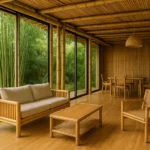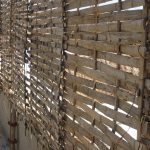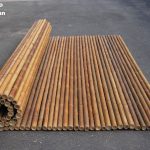Sustainable living has transformed our perspective on the spaces we inhabit. More and more people want homes that reflect their values, such as natural, ethical, and earth-friendly. But the challenge is clear. How do you create a beautiful, modern home without relying on materials that harm the environment?
Bamboo offers a refreshing solution. This fast-growing plant is tough, elegant, and easy on the earth. It helps reduce carbon in the atmosphere, needs very little water to grow, and works beautifully across all kinds of design.
In this article, we’ll walk through how bamboo is reshaping architecture, interior design, and furniture. We’ll also cover the things people often miss: durability, maintenance, cost comparisons, and real examples of bamboo in action.
If you’re exploring new ways to design with purpose, you’ll want to read on. Let’s get started.
Why Bamboo Is the Poster Child of Sustainable Living
Sustainable living means making practical choices that reduce environmental impact. This includes everything from what you buy to how you build. And bamboo is an excellent material for people pursuing a sustainable lifestyle.
But what makes bamboo so exceptional? It grows in just a few years, needs little water, and absorbs large amounts of carbon dioxide. It proves to be a great option for reducing emissions.
This plant is gentler on the planet than traditional materials as well. You’ll find it often in eco-friendly buildings and modern green furniture now. Designers and homeowners are picking it for its natural look, strength, and its lighter consequences on the environment.
How Does Bamboo Compare to Other Materials?
Here’s a quick look at how bamboo compares against timber, plastic, and steel:
| Feature | Bamboo | Timber | Plastic | Steel |
| Growth Time | 3 to 5 years | 20 to 60 years | N/A | N/A |
| Water Use | Low | Moderate to High | Low | High |
| Carbon Absorption | Very High | Moderate | None | None |
| Biodegradable | Yes | Yes | No | No |
| Energy to Produce | Low | Moderate | High | Very High |
Bamboo clearly leads the pack when it comes to eco-benefits. So if you’re asking, “Is bamboo really sustainable?” The short answer is yes. And compared to hardwoods, the environmental impact is dramatically lower.
Beyond the Surface: Bamboo in Modern Architecture
Modern architecture focuses on simplicity, openness, and connection to nature. You’ll frequently see large windows, flat planes, and a mix of clean lines and natural textures.

Today, materials matter just as much as layout, and designers look for options that support both aesthetics and sustainability. Bamboo aligns perfectly here with these goals.
Around the world, bamboo is being used in striking ways. From eco-resorts in Bali to cultural spaces in Colombia, and even suburban homes across Australia, it’s gaining popularity as a primary building material.
Bamboo’s smooth finish, natural warmth, and earthy tones make it a favourite in modern designs that aim to feel grounded yet sophisticated.
Why Bamboo Works in Architecture
Bamboo has a high strength-to-weight ratio, making it ideal for load-bearing designs. It flexes under pressure rather than snapping, and this adaptability adds resilience to structures exposed to movement or unstable foundations. It’s also easy to shape into both curved and straight beams, giving architects creative freedom.
How long does bamboo architecture last?
When properly treated and maintained, bamboo can withstand decades of use. In well-built structures, it commonly lasts 30 years or more. And with appropriate protective finishes, it effectively resists pests, moisture, and sun exposure.
From Floor to Ceiling: Bamboo in Interior Design
Bamboo has become an excellent choice in interior design for people who want natural beauty without sacrificing sustainability. It brings warmth, texture, and tranquility to a space while supporting eco-friendly living.
Since bamboo is durable, fast-growing, and renewable, it works across a variety of design styles and climates. It also holds its own in terms of cost and care when compared to traditional materials like hardwood or vinyl.
Here’s how bamboo fits into interiors, practically and beautifully.
- Flooring That Lasts and Looks Good: Bamboo flooring offers the elegant look of hardwood at a more accessible price and with a lighter environmental impact. It’s hard-wearing, scratch-resistant, and ideal for busy homes with kids or pets.
Pro Tip: Based on our firsthand experience, strand-woven bamboo performs especially well in humid or warm conditions and is less prone to swelling than timber. - Panels and Wall Treatments for Natural Texture: Bamboo wall panels are perfect for adding a layer of visual interest without making a room feel heavy. They bring depth and organic texture, especially when used in Japandi or rustic interiors. These panels are also a great way to break up plain walls in living rooms, entryways, or feature spaces.
- Dividers and Partitions With Purpose: Bamboo partitions can help define spaces without fully closing them off, keeping natural light flowing and rooms feeling open. They’re great for separating workspaces from lounges or creating a sense of privacy in open-plan homes. Their lightweight and minimal aesthetic makes them easy to install and adapt.
- Ceiling Features for a Finished Look: Ceiling applications like bamboo cladding or beam accents can completely transform a space. They warm up areas that might otherwise feel cold and add a noticeable design element with a natural twist. This style works especially well in coastal, tropical, or nature-inspired interiors.
In terms of care, bamboo interiors are simple to maintain. A soft cloth and mild soap usually do the trick, and sealed bamboo resists moisture well. Compared to hardwood, it’s often more stable in changing climates and holds up just as long with proper care.
The Rise of Bamboo Furniture: Trend or Transformation?
Bamboo furniture started gaining attention in the late 2000s as eco-conscious consumers began searching for greener alternatives to traditional wood and plastic. What began as a niche interest has steadily grown into a serious design movement.
Today, bamboo furniture is turning heads in both minimalist city apartments and stylish, nature-inspired homes. The question now is: is this just a passing trend, or are we witnessing a lasting change in how furniture is made and valued?
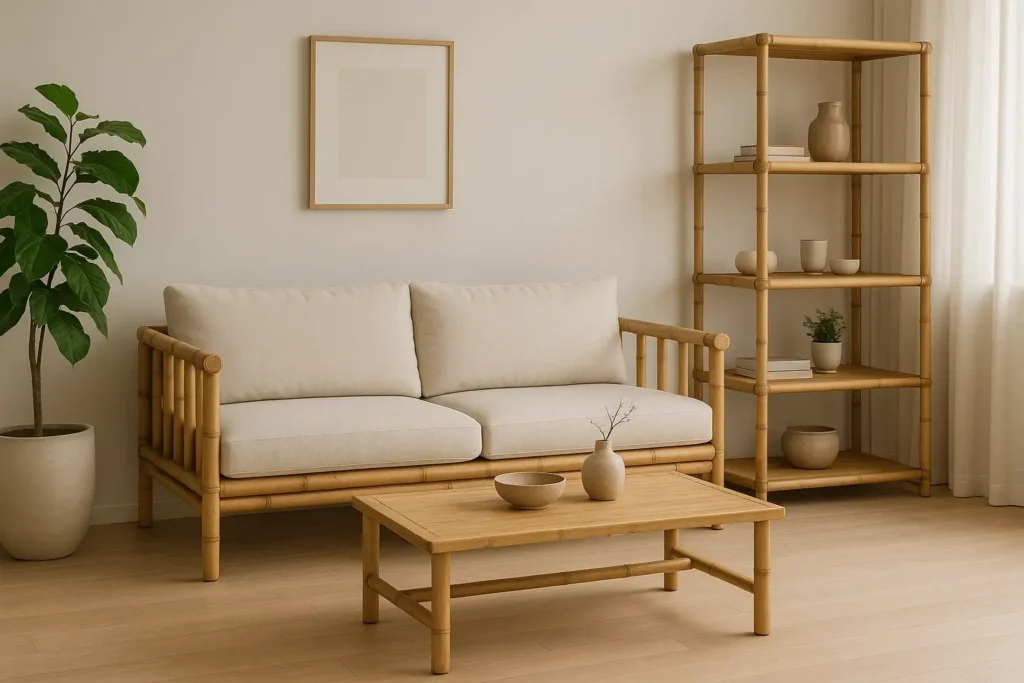
What makes bamboo furniture unique is its versatility. You’ll find it crafted into everything from lightweight chairs and sturdy dining tables to platform beds, open shelving, and modular storage. It’s naturally strong yet easy to move, making it perfect for renters and homeowners alike.
Some still associate bamboo with “cheap” outdoor pieces, but that’s quickly changing. As one customer said after buying a bamboo sideboard, “I never thought bamboo could look this high-end. It’s become the best piece in my home.”
Of course, not all bamboo products are equal. Ethically harvested bamboo supports both people and the planet, while mass-produced pieces may cut corners in quality and sourcing.
So, is bamboo furniture worth it? In the next section, we’ll look at what to consider and how it performs over time.
Ethical Sourcing and Local Impact
Ethical sourcing means choosing materials that are grown, harvested, and processed in ways that protect both people and the environment. When it comes to bamboo, this includes fair wages for growers, safe working conditions, and farming practices that preserve ecosystems.
These decisions affect the environment, the local economy, and the quality of the finished product.
Based on our experience, FSC-certified and fair-trade bamboo tends to be more consistent, durable, and better finished than cheaper, mass-market alternatives.
It supports farmers and workers in countries like India, Vietnam, and Kenya, where bamboo farming helps strengthen rural communities.
Here’s a quick look at sourcing differences:
| Sourcing Type | Ethical (FSC/Fair-Trade) | Mass-Produced Bamboo |
| Environmental Impact | Low | High |
| Worker Treatment | Regulated | Often Unclear |
| Material Quality | Consistent | Varies |
| Long-Term Durability | Strong | Often Lower |
There are also great community-led bamboo projects in Australia that support Indigenous land use and sustainable agriculture.
Real Homes, Real Results: Case Studies and Examples
Real-world examples show bamboo’s practical performance and demonstrate its durability. They also explain its cost-effectiveness and adaptability to various lifestyles.
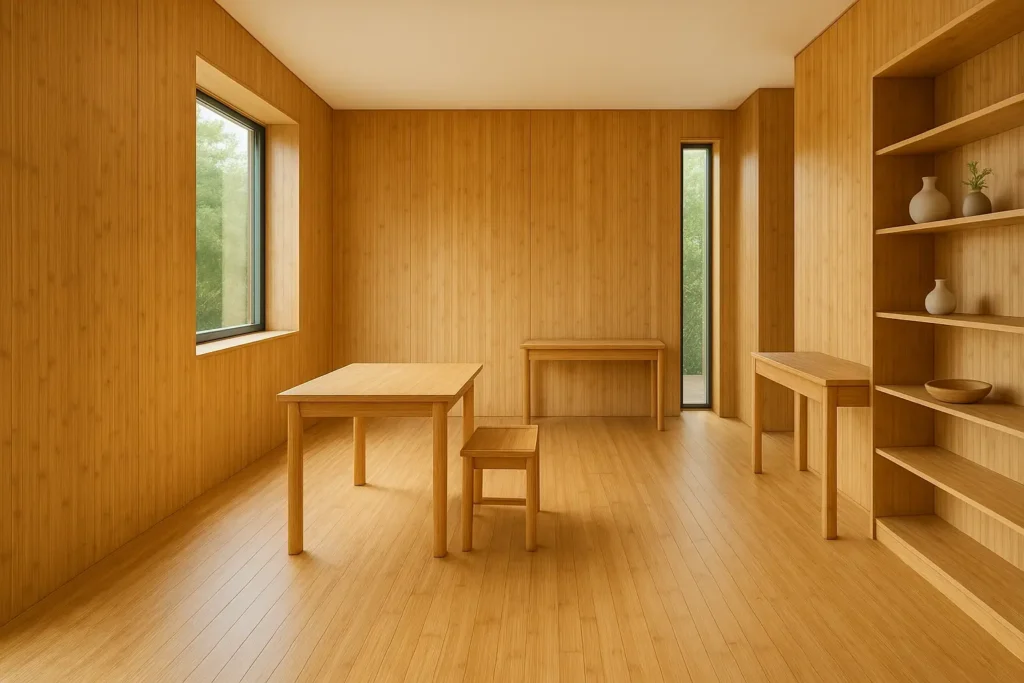
The following stories will give you insight into both the financial benefits of bamboo living and its endless design possibilities.
A Bamboo Extension in Queensland
After outgrowing their weatherboard home, a Queensland couple chose bamboo for their new extension. They used bamboo flooring, internal panelling, and outdoor decking. Their decision was driven by the material’s low environmental impact and natural finish.
Result: Energy bills dropped thanks to bamboo’s insulating properties, and maintenance has remained minimal after four years. The couple says guests always comment on the warm, calming vibe of the space.
Biophilic Bamboo in a City Apartment
In Melbourne, a young professional transformed a compact apartment using bamboo cabinetry, floating shelves, and ceiling cladding. The goal was to feel more connected to nature without losing a modern edge.
Result: Daily stress levels dropped noticeably, and the flat felt bigger and more peaceful. Friends often describe the space as “a breath of fresh air in the city.”
Sustainable Cafe Fit-Out in Byron Bay
A local cafe owner in Byron Bay wanted the interior to reflect their commitment to sustainable living. They chose bamboo for benchtops, furniture, and ceiling features, all sourced from local FSC-certified suppliers.
Result: The cafe’s earthy, relaxed atmosphere quickly became a hit with customers. The owner reports that the bamboo surfaces have held up well under heavy use, and the eco-friendly design has become part of their brand story.
These real-life stories give us a clear look at how bamboo performs in everyday settings. Still, many people wonder how bamboo compares when it comes to price and long-term value.
In the next section, we’ll break down the costs and see how it holds up over time.
The Numbers Game: Cost and Value Over Time
Sustainable living typically starts with picking the right materials. But for those choices to truly matter, they need to maintain performance over time.
Bamboo proves effective here because it balances its initial cost with long-term value. It’s good for the planet. And it also saves homeowners from constant replacements and expensive maintenance.
What You Might Pay
Bamboo generally costs less than traditional hardwood while offering a clear upgrade from cheap synthetic options. It fits various budgets without compromising on quality.
- Flooring: $60 to $110 per square metre for strand-woven or engineered bamboo. Premium versions may have protective coatings and better joining systems.
- Furniture: $150 to $2,000 per piece. Lower-cost options are flat-packed, while handcrafted or custom items sit higher.
- Decor and panels: $40 to $90 per square metre. Pricing depends on thickness, finish, and whether acoustic or fire-rated treatments are applied.
Why Bamboo Offers Strong Long-Term Value
Good materials should last and stay low-maintenance. Bamboo performs well in both areas and brings extra value through natural climate control.
- Requires little maintenance and does not need constant polishing or sealing.
- Natural insulation can help regulate indoor temperatures, lowering power bills.
- Lasts 20 to 30 years indoors when properly installed and kept dry.
- Endures everyday wear in kitchens, lounges, and other high-traffic areas.
Bamboo vs Traditional Materials
Durability, maintenance, and environmental impact often decide which material works best. Bamboo offers strong performance across all three.
| Feature | Bamboo | Hardwood | Vinyl |
| Upfront Cost | Lower to moderate | Moderate to high | Low |
| Lifespan | 20 to 30 years | 20 to 50 years | 10 to 20 years |
| Maintenance Needs | Low | Medium to high | Medium |
| Environmental Impact | Low | Moderate | High |
| Energy Benefits | Good insulation | Moderate | Poor |
So, is bamboo cost-effective for sustainable living? In most cases, yes. Its low maintenance, long lifespan, and thermal benefits often outweigh slightly higher upfront costs.
Future Forecast: The Role of Bamboo in Green Innovation
Bamboo continues to play an expanding role in green innovation. Its rapid growth, renewability, and low carbon footprint have already made it a staple in sustainable living. Now, researchers, architects, and designers are pushing the boundaries of what this natural material can do, establishing it as a central player in future-focused design and construction.

Emerging technologies are giving bamboo a new identity. Bamboo composites, made by combining natural fibres with resins, are being developed for use in lightweight panels, insulation, and even structural elements.
In research facilities and workshops, bamboo is being used in 3D printing to create strong, sustainable components for furniture and modular homes. These advances help reduce material waste and increase the precision of eco-friendly building.
From a policy perspective, more governments are supporting bamboo farming and processing through grants and regulatory changes. Eco-startups are also entering the market, using bamboo for products like bike frames, reusable utensils, and low-impact packaging.
The material is also catching on because it’s practical, beautiful, and easy to work with.
Looking ahead, bamboo may form the structure of entire prefabricated housing kits designed for energy efficiency and affordability. Some urban planners are even exploring concepts for bamboo-based neighbourhoods focused on renewable materials and low-emission living.
The future of bamboo in sustainable design is full of exciting possibilities that go well beyond the basics.
Designing a Greener Future with Bamboo
Bamboo has earned its place in sustainable design by offering strength, style, and real environmental benefits. It works across flooring, furniture, interiors, and architecture, with practical advantages like durability, energy savings, and low maintenance.
Throughout this article, we’ve seen how bamboo supports eco-friendly choices without sacrificing comfort or creativity. Bamboo proves its value again and again, from community homes in Queensland to high-rise apartments and future-focused innovations.
If you’re thinking about using bamboo in your next home, workspace, or project, now is a smart time to take action. At Bamboo Expo, we provide hands-on design consultation, sourcing support, and custom fabrication to help bring your ideas to life.
Our team has worked with architects, builders, and homeowners across Australia to create solutions that are both sustainable and unique.
Ready to get started? Contact us today and let’s start building something greener together.



